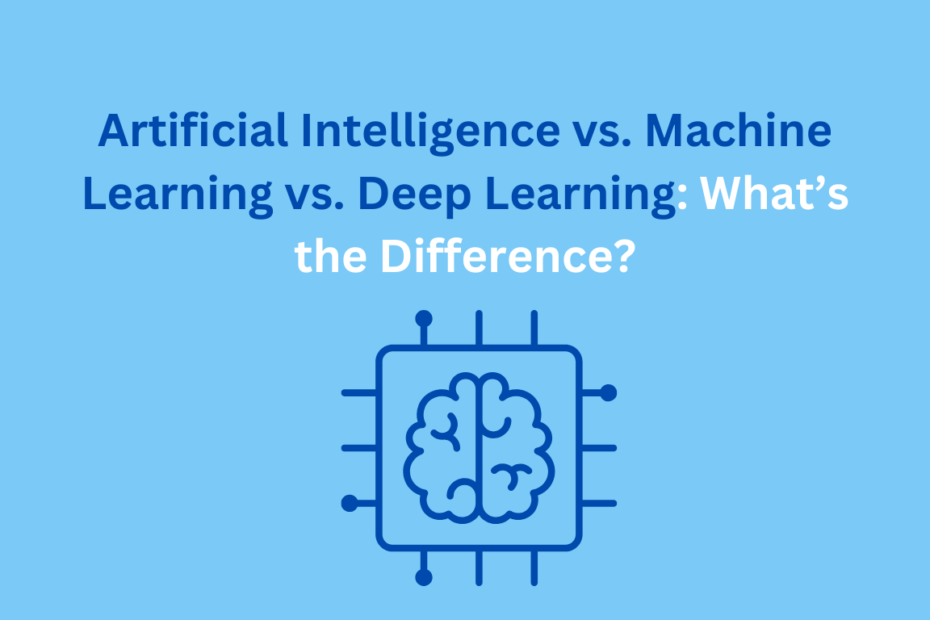AI vs. ML vs. DL : What’s the Difference?
Introduction
Technology is evolving rapidly, and we often hear terms like Artificial Intelligence (AI), Machine Learning (ML), and Deep Learning (DL). While these terms are related, they are not the same. Understanding the differences between AI vs ML vs DL can help businesses, students, and technology enthusiasts understand their importance and applications.
In this article, we will explain AI, ML, and DL in simple words, highlight their differences, and explore how they work together in real-world applications.
What is Artificial Intelligence (AI)?
Artificial Intelligence (AI) is the broadest term that refers to machines or software programs that can perform tasks that usually require human intelligence. These tasks include problem-solving, decision-making, understanding language, and recognizing patterns.
AI can be categorized into three types:
- Narrow AI – This is AI designed to perform a specific task, like voice assistants (Siri, Alexa) or recommendation systems (Netflix, YouTube).
- General AI – This AI would be capable of thinking and learning like a human, but it doesn’t exist yet.
- Super AI – A hypothetical AI that surpasses human intelligence. This is still a concept in science fiction.
AI is used in many industries, including healthcare (diagnosing diseases), finance (detecting fraud), and entertainment (personalized recommendations).
What is Machine Learning (ML)?
Machine Learning (ML) is a branch of AI that allows computers to learn from data and improve their performance over time without explicit programming. Instead of being given exact instructions, ML models use patterns in data to make decisions.
Machine Learning is divided into three main types:
- Supervised Learning – The model is trained with labeled data. For example, an email spam filter learns by being shown examples of spam and non-spam emails.
- Unsupervised Learning – The model finds patterns in data without labeled examples. A common example is customer segmentation in marketing.
- Reinforcement Learning – The model learns by trial and error, receiving rewards for correct actions. Self-driving cars and game-playing AI use this method.
ML is widely used in recommendation systems (Amazon, Netflix), fraud detection (banks), and self-driving technologies.
What is Deep Learning (DL)?
Deep Learning (DL) is a specialized form of Machine Learning that uses artificial neural networks to process and analyze large amounts of data. These neural networks are inspired by the human brain and allow computers to learn complex patterns and make intelligent decisions.
Deep Learning is particularly effective in areas that require high accuracy, such as:
- Image and speech recognition (e.g., Face ID, Google Photos, voice assistants).
- Natural Language Processing (NLP) (e.g., chatbots, automatic translations, sentiment analysis).
- Autonomous systems (e.g., self-driving cars, robotics, advanced gaming AI).
Deep Learning requires large amounts of data and high computational power but delivers more accurate results than traditional Machine Learning.
AI vs. ML vs. DL: Key Differences
To make the differences clearer, here’s a simple comparison:
| Feature | AI | ML | DL |
|---|---|---|---|
| Definition | Broad field of creating smart systems | Subset of AI focused on learning from data | Subset of ML using neural networks |
| Data Dependency | Can work with structured and unstructured data | Needs structured data | Requires large amounts of data |
| Human Intervention | May require programming and rules | Needs human input for selecting features | Minimal human intervention needed |
| Complexity | Can be simple (rule-based) or complex (learning-based) | More complex than traditional AI | Very complex with deep neural networks |
| Examples | Chatbots, automation, robotics | Fraud detection, recommendation engines | Facial recognition, self-driving cars |
How AI, ML, and DL Work Together
AI is the big picture, ML is a way to achieve AI, and DL is an advanced form of ML. Think of it this way:
- AI is the entire field.
- ML is a technique within AI.
- DL is a more advanced form of ML.
For example, let’s consider self-driving cars:
- AI powers the entire system.
- ML helps the car recognize objects like traffic signs and pedestrians.
- DL allows the car to improve its decision-making using deep neural networks.
Real-World Applications
- AI in Healthcare – AI helps doctors diagnose diseases and recommend treatments.
- ML in Finance – ML models detect fraudulent transactions and assess credit scores.
- DL in Automotive – Deep Learning helps self-driving cars recognize roads, pedestrians, and traffic signals.
Conclusion
Artificial Intelligence, Machine Learning, and Deep Learning are all connected but serve different purposes. AI is the broadest concept, ML allows computers to learn from data, and DL improves ML with deep neural networks. Understanding these differences can help businesses and individuals leverage these technologies effectively.
Read More : Artificial Intelligence: The Future is Now
FAQs
1. What is the main difference between AI, ML, and DL?
AI is about creating smart systems, ML allows machines to learn from data, and DL uses deep neural networks for better accuracy.
2. Is deep learning better than machine learning?
Deep Learning is better for tasks requiring high accuracy and large datasets, but it also needs more computing power and data.
3. Can AI exist without machine learning?
Yes, AI includes rule-based systems that don’t rely on ML, such as simple chatbots and automation tools.
4. What are some real-world examples of deep learning?
Deep Learning is used in self-driving cars, voice assistants, facial recognition, and medical image analysis.
5. Which field has more job opportunities: AI, ML, or DL?
All three fields have high demand, but ML and DL roles are particularly sought after in data science, automation, and AI-driven industries.
With AI, ML, and DL shaping our future, learning about these technologies can open up exciting career opportunities and innovations!

